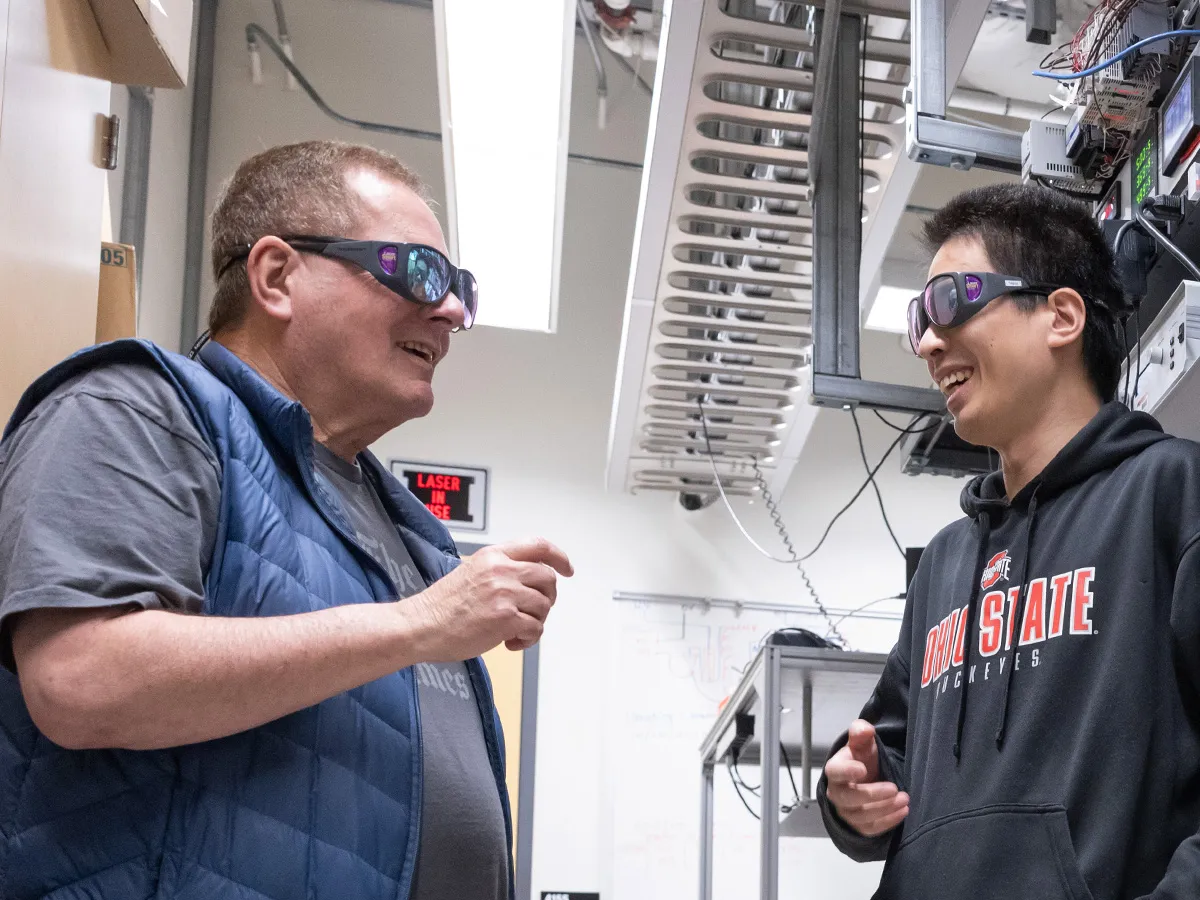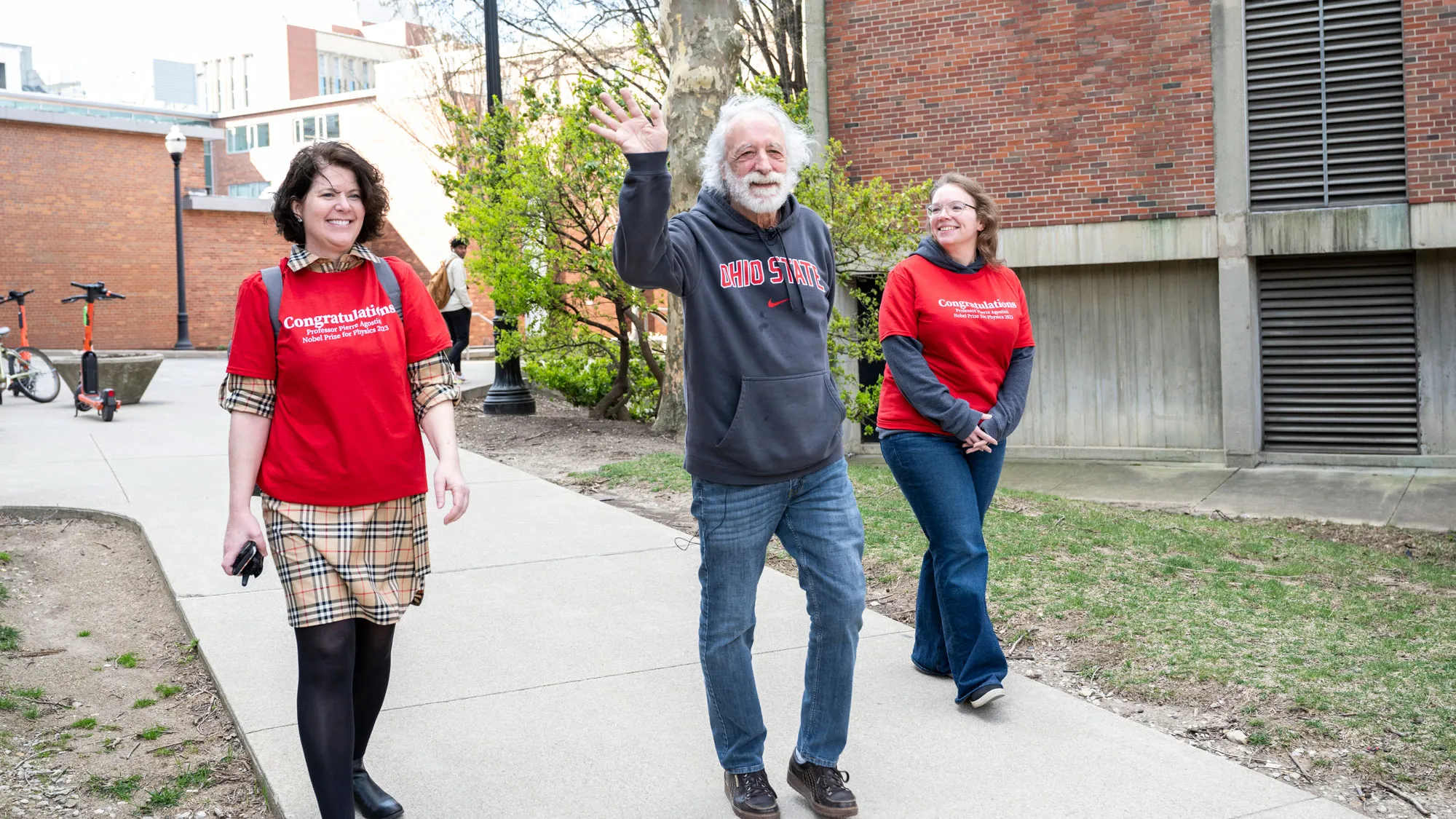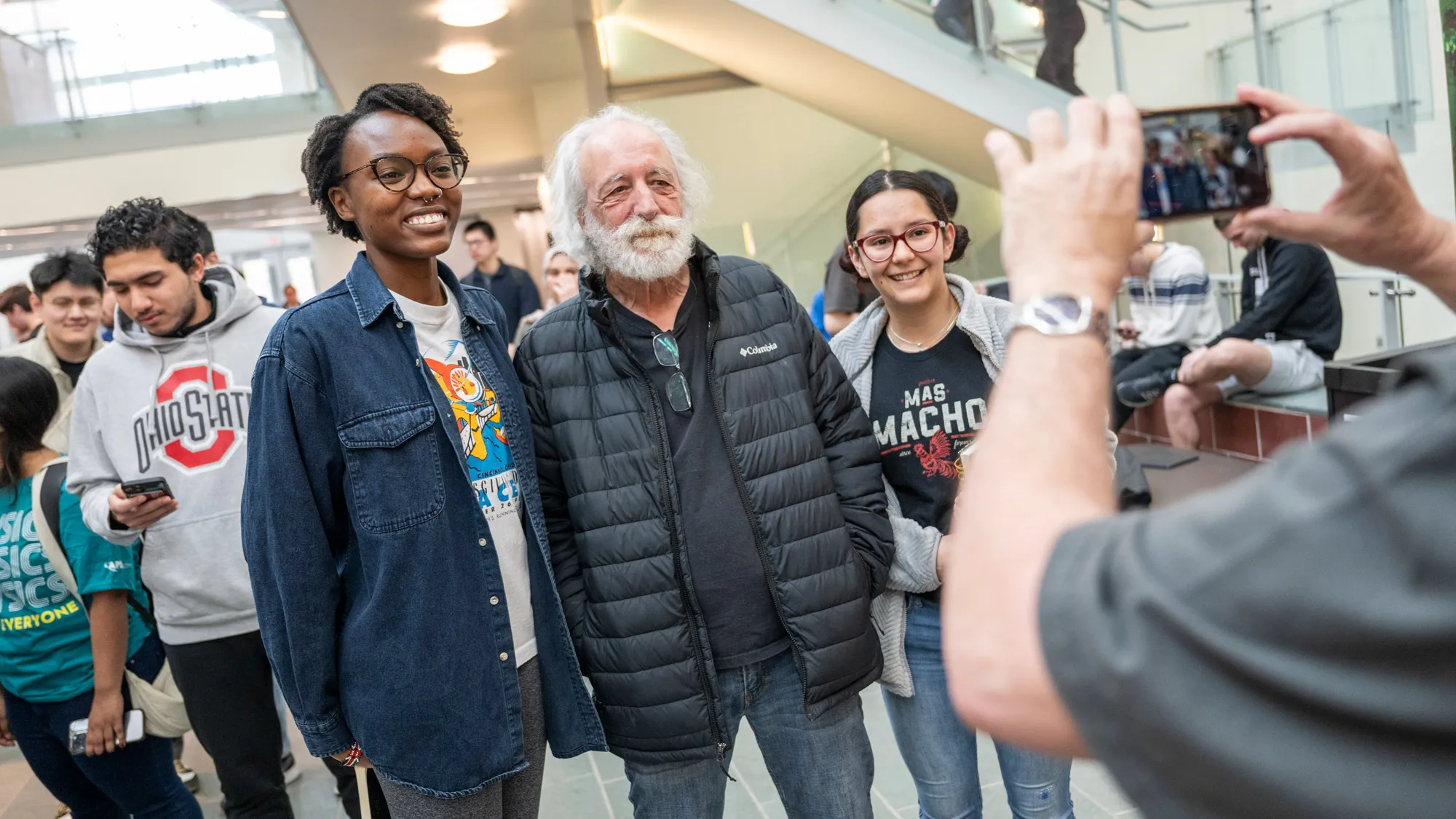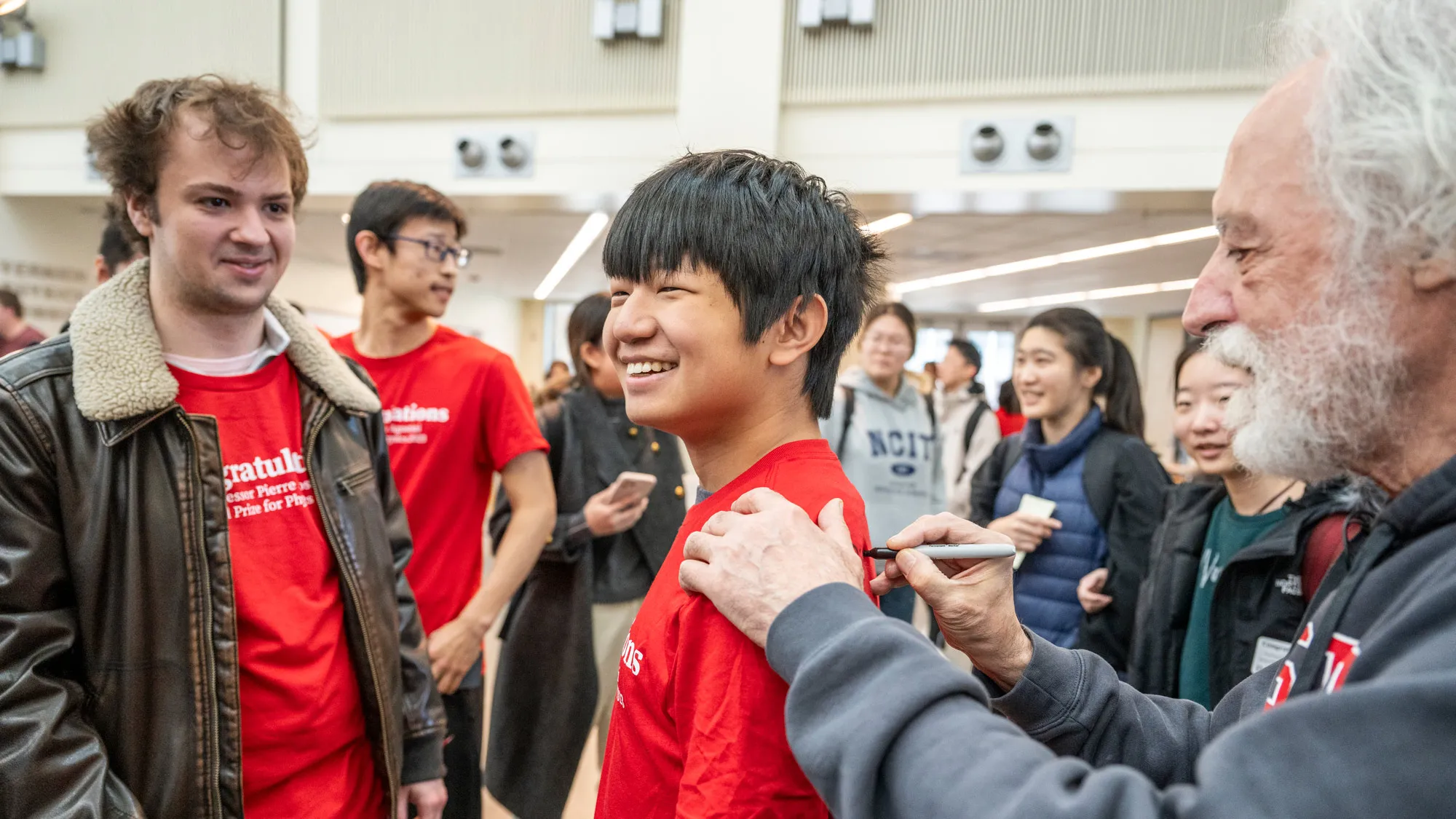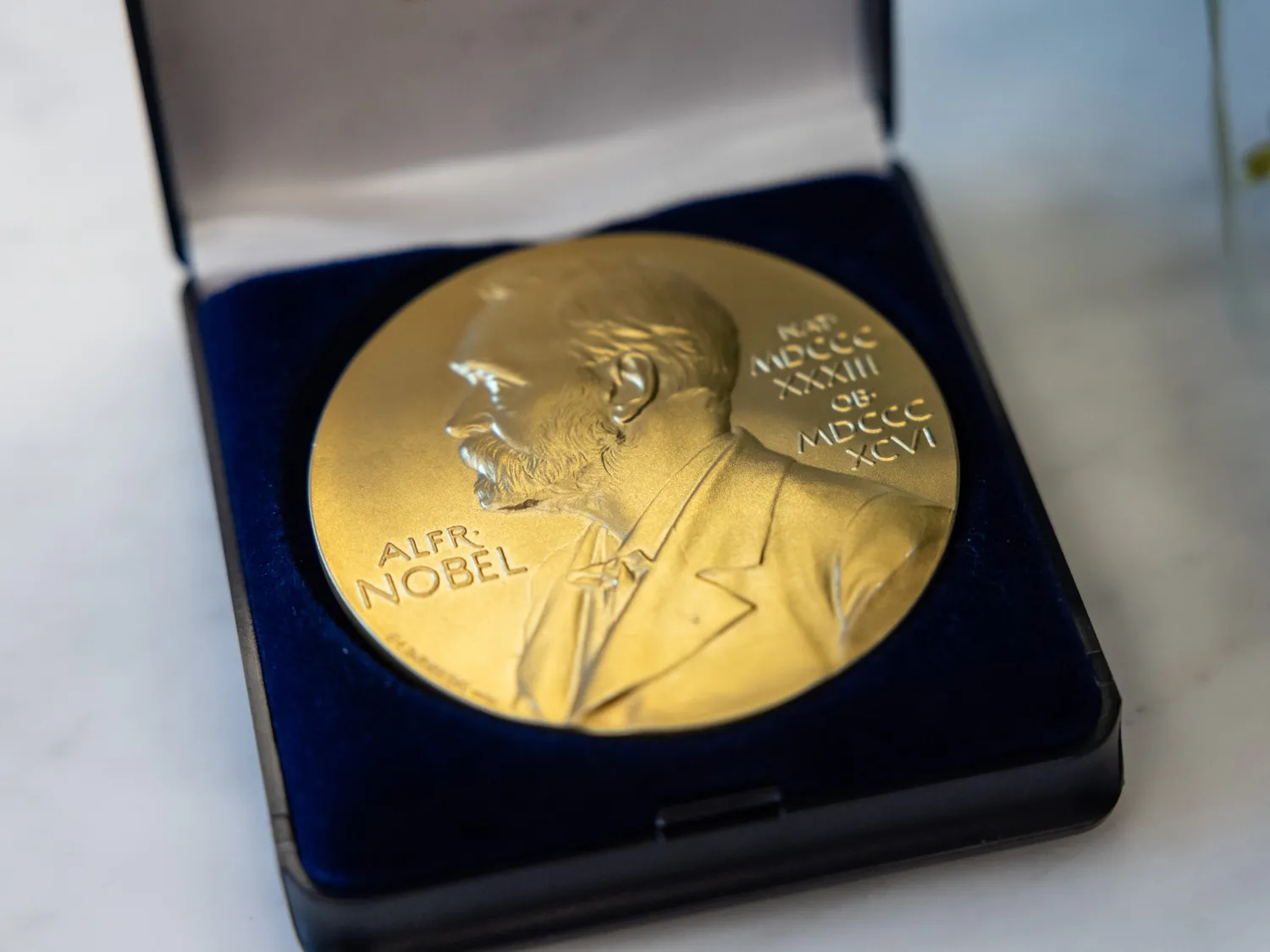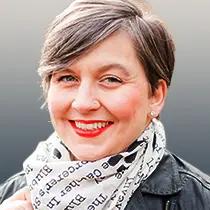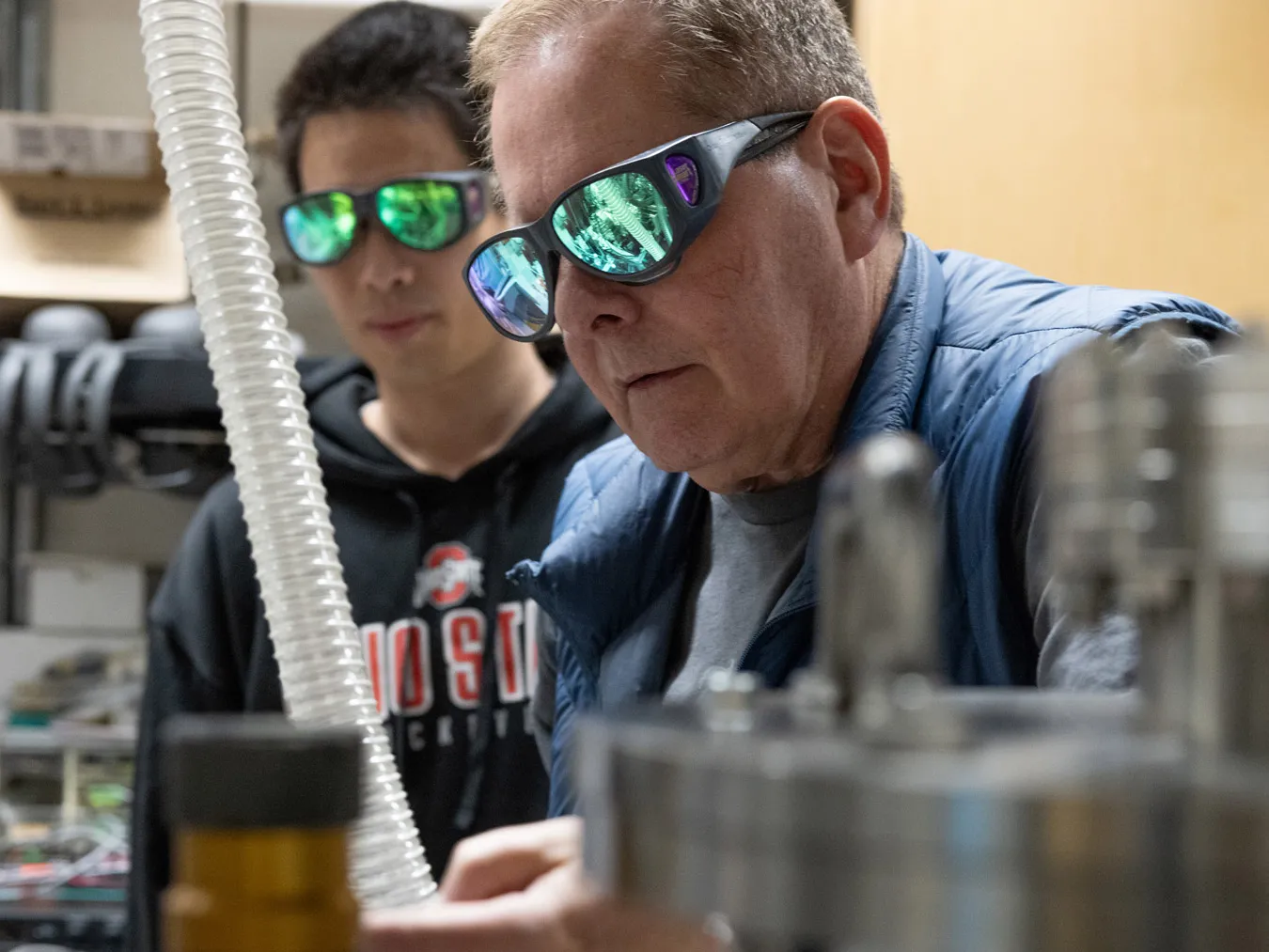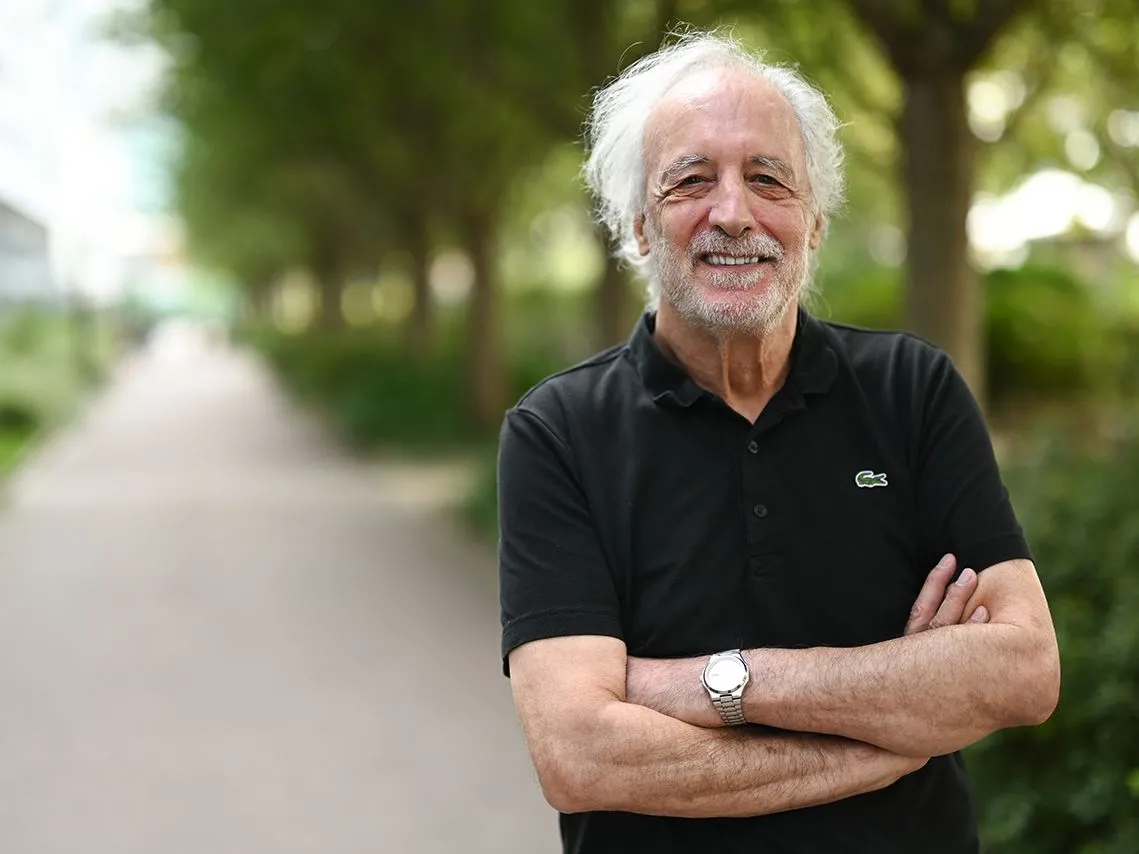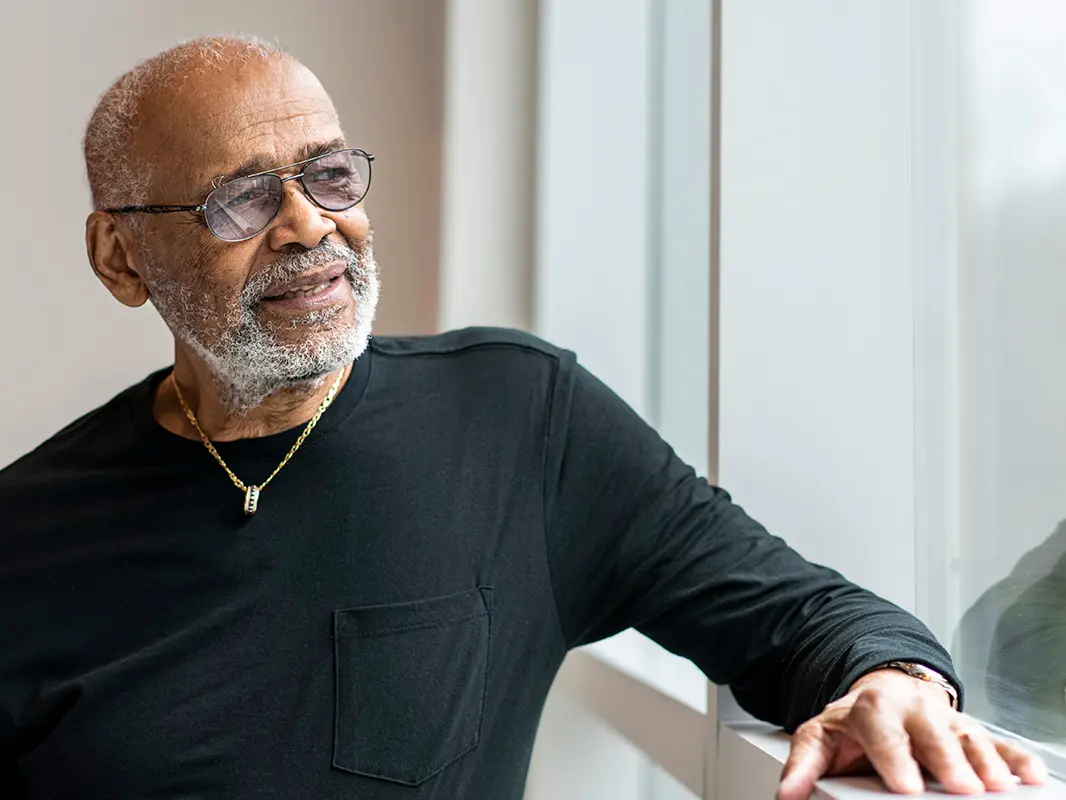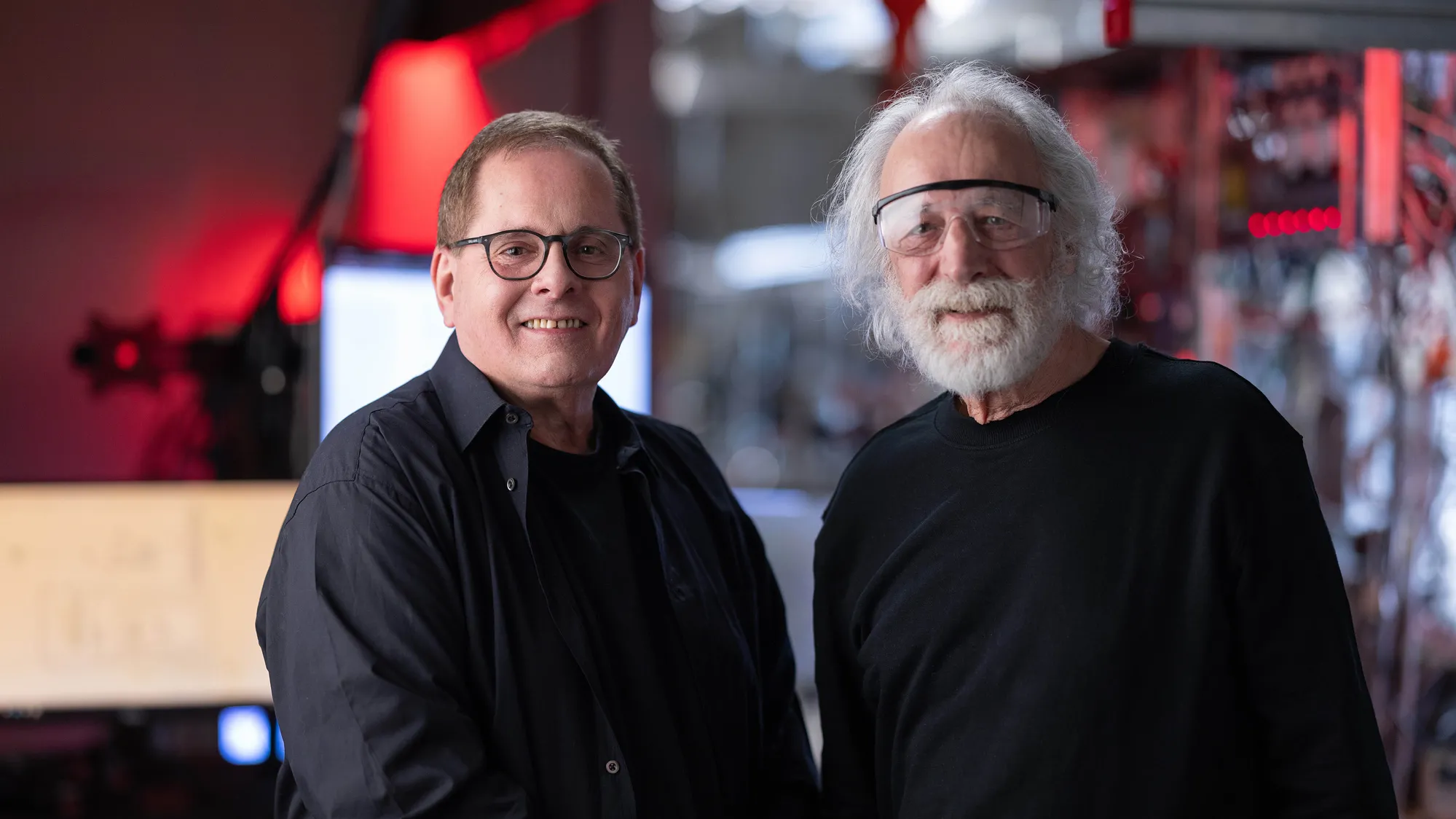
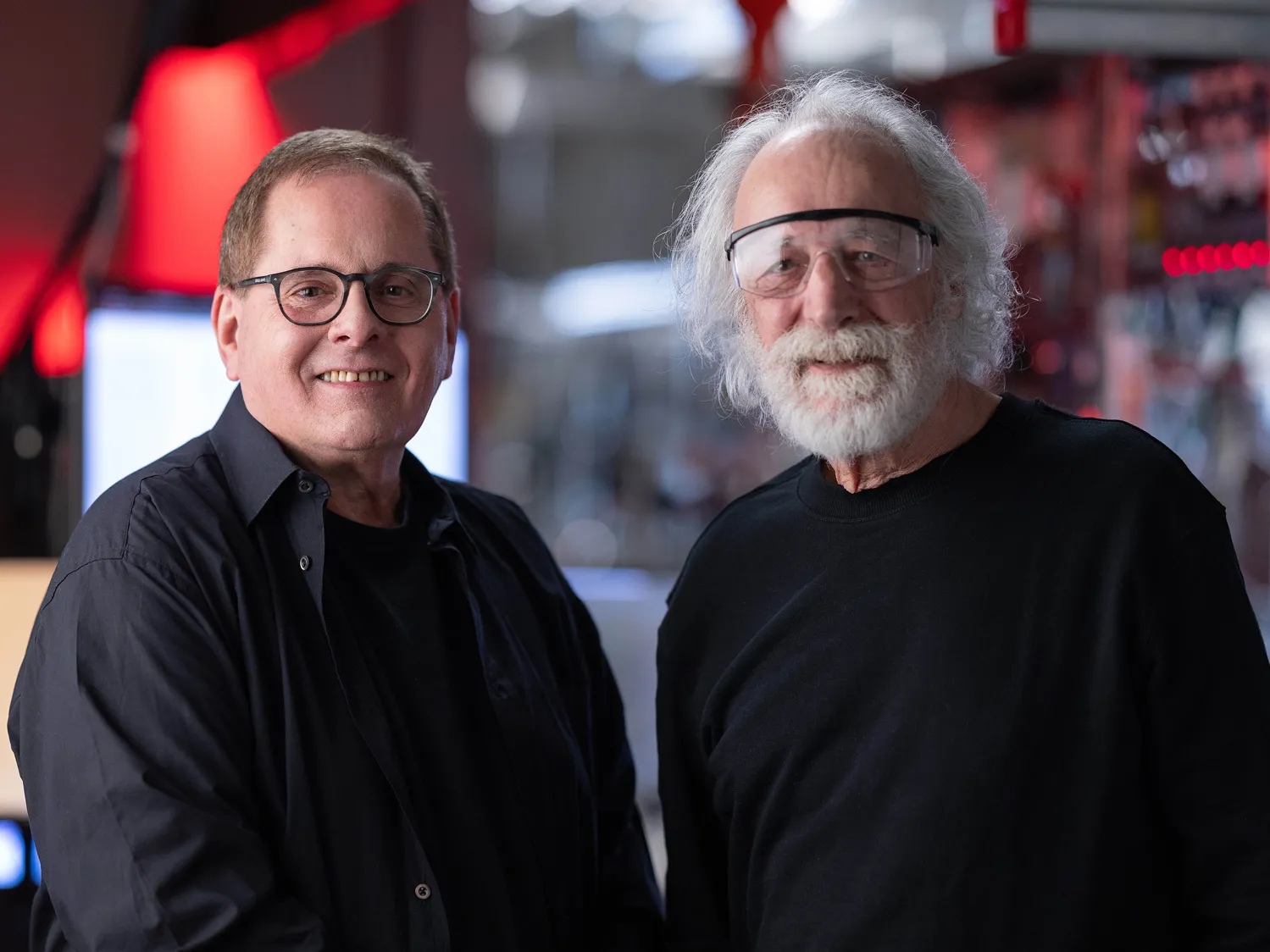
The long and short of it
Professors Lou DiMauro and Pierre Agostini, a 2023 Nobel laureate, are developing the next generation of big thinkers.
At Ohio State, discoveries involving subatomic particles, using the shortest known increments of time, can take years. Yet the generations of students working in the Agostini-DiMauro Research Group take away important lessons every day.
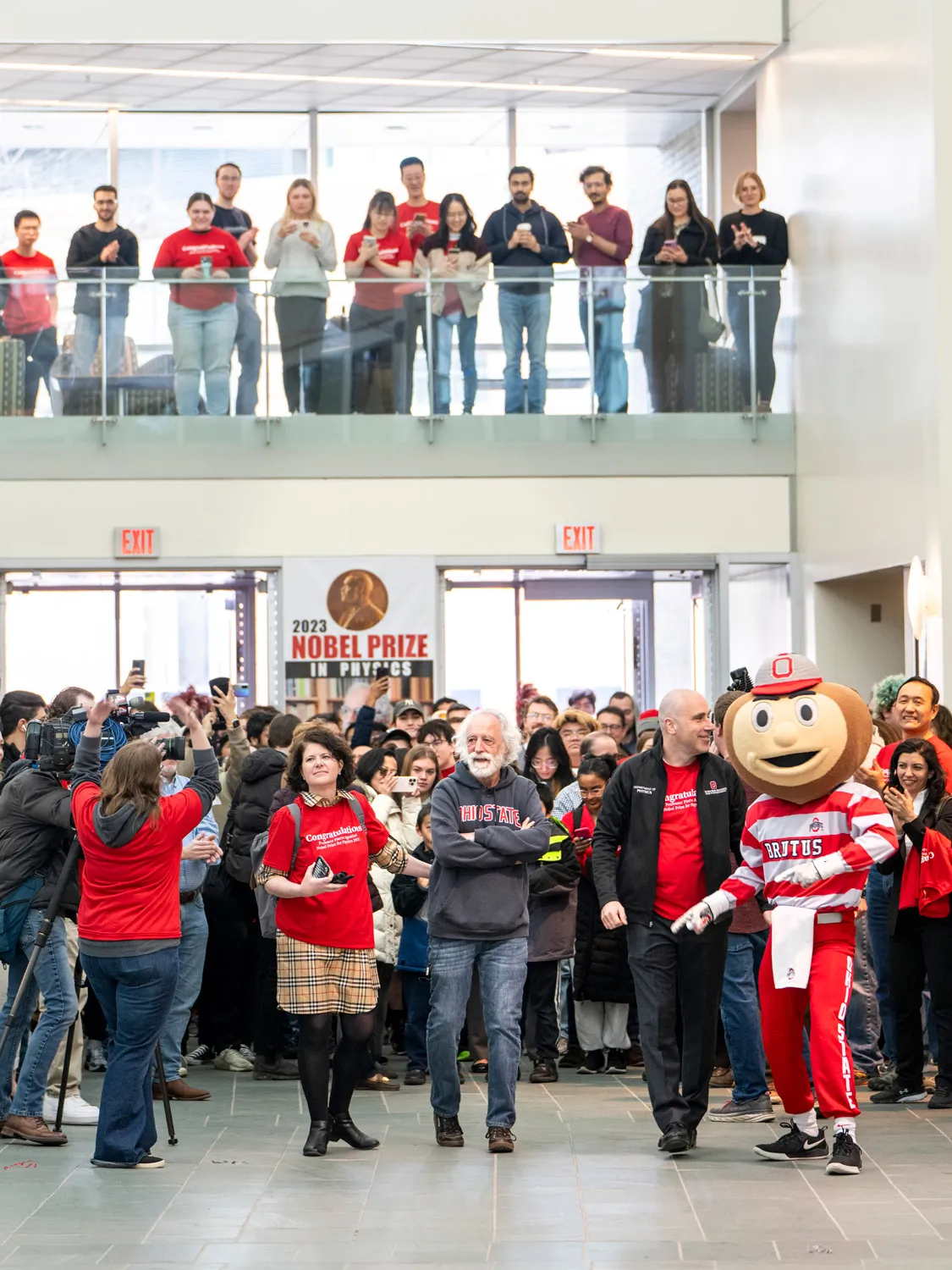
Dozens of people joined the clap-in to welcome Agostini back to campus in the spring and celebrate his Nobel win. Here they seek good vantage points to cheer for him inside the Physics Research Building. (Photo by Logan Wallace)
Pierre Agostini, a 2023 recipient of the Nobel Prize in Physics, and his longtime lab partner DiMauro could conduct research elsewhere. Agostini’s Nobel Prize aside, both physicists are decorated giants in their field. They chose Ohio State 20 years ago and, for many reasons, have continued to choose the university as the site for their work. Access to talent, space, equipment, funding, collaborations with other institutions and support are among them.
Crucially, Agostini and DiMauro share a deep commitment to shaping the next generation of scientists. Those who work in their lab say they are taken seriously from day one. Welcomed into an environment that is equal parts rigorous and inquisitive, students and postdocs see in these physicists the type of leaders they wish to become. The mentors come across as affable, self-deprecating, curious, kind. If they feel they’ve reached pinnacles, it doesn’t show in their pursuit of knowledge, though both are aware they are nearing the end of their careers.
Liu characterizes his professors’ ethos like this: “Regardless of stature and glory, just do good work and be critical of your work.”
The paths of DiMauro and Agostini first converged in the late 1980s and early ’90s, when DiMauro was a junior scientist at Brookhaven National Laboratory in New York and Agostini was an expert at CEA Paris-Saclay, a national research center of the French Alternative Energies and Atomic Energy Commission. Paris-Saclay had been Agostini’s professional home since he’d completed graduate studies, and it is where he conducted work that led to the Nobel Prize: In 2001, he and fellow researchers calibrated attoseconds by creating a train of pulses, each 250 attoseconds in duration.
DiMauro and Agostini collaborated in strong-field laser science — the study of how high-power lasers interact with solids and gases — throughout the ’90s. When DiMauro was recruited to Ohio State in 2004, he all but made it a condition of his acceptance that Agostini be asked to join the faculty, too.
Agostini came to Columbus in 2005 and reached emeritus status in 2018. They became friends, sharing taste in music and Marx Brothers films. “There’s a kinship and friendship that develops that releases barriers. We can toss around crazy ideas. We’re not trying to impress each other,” DiMauro says. Asked during an April colloquium at Ohio State to name some of the most meaningful moments in his career, Agostini paused and then replied, “Maybe the time I met Lou DiMauro.”
DiMauro found the experience of re-establishing his lab in Columbus refreshing and exciting. The Department of Energy wanted to continue to fund his work, and he was now open to apply for other funding. “The fact that I came to Ohio State allowed me to expand the group. These ideas were all in my head when I was at Brookhaven, but I didn’t have enough manpower to carry them out,” he says.
Today, the Agostini-DiMauro group is funded by the DOE, the National Science Foundation, the scientific arm of the U.S. Air Force and other sources. Diverse organizations have an interest in this research — for sheer scientific discovery, national security and technological implications. Where DiMauro worked with a few graduate students and a postdoctoral fellow at Brookhaven, the lab at Ohio State quickly expanded to fund 15 grad students and postdocs. This is an unusually large lab with ample longevity and continuity — the type of structure needed to pry open discoveries in atomic physics.
As research assistants gain seniority and experience, they work more closely with DiMauro and Agostini, gradually becoming colleagues able to hold their own in complex conversations and debates, challenging the faculty members, devising experiments and becoming co-authors.
“I like to give them their own space to develop,” says DiMauro, Ohio State’s Dr. Edward E. and Sylvia Hagenlocker Chair in Physics. “I want them to be the master of the experiment, not me.”
Alumni who have thrived in this collaborative environment say they are propelled by the inquisitive, open culture Agostini and DiMauro encourage.
“They put the work first, and there’s always more to be improved. They’re not complacent,” Liu says. “We could discuss the usage of a word for hours on end. The specificity, the technicality really rubs off on you. Their passion rubbed off on me, seeing the attitude and, for some folks, obsession. These people care.”
Piper found that to be the case, too, and admired how his professors engaged, followed through and sparked curiosity. After graduating, he took a job with IonQ, a quantum computing company in College Park, Maryland.
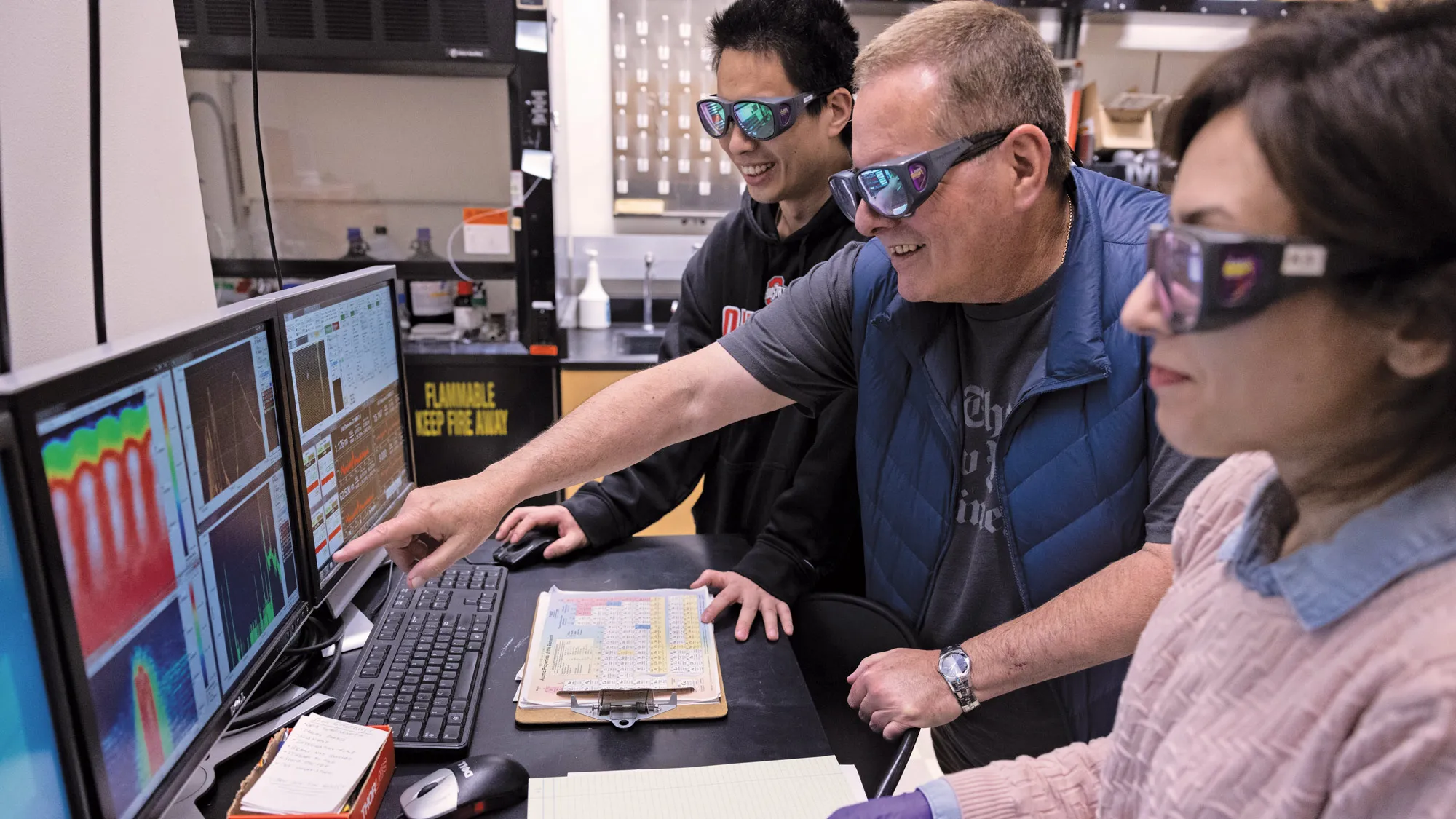

“I was proud to represent Ohio State’s scientific community in Stockholm,” Agostini said in sharing a Nobel medal replica with Physics Chair Michael Poirier. (Photo by Logan Wallace)
The experimental action in attophysics occurs between those pulses. One of the experimental fields is recollision physics — the purpose of DiMauro’s quantum trajectory selector.
Scientists working in the fields of atomic physics and optics keep discovering new ways to slice time into ever-finer slivers in service to the exploration of electron behavior. In his Nobel lecture, delivered in December 2023, Agostini said this progress will come to a necessary end. “Is time infinitely divisible? From a physics point of view that’s doubtful because it takes more and more energy to produce those short pulses,” Agostini says. “We are still very far from that time, but you cannot divide time infinitely.”
Not even physicists see or feel the phenomena they study — they experience them only through data captures and visualizations. Hence, DiMauro says imagination has served him incredibly well throughout his life.
“I always thought about problems that I kind of think are going to take at least 10 years or more to solve. If you’re closing shop in, say, two years, I have to throw those things out of my mind, which is throwing out the imagination part,” says DiMauro, 71, who is starting to consider retirement. “It’s been a very important part of how I and people like Pierre work. The imagination is something that never leaves your head.
“I believe that a very successful scientist has two, maybe three good ideas in their career. I can point to myself and mark where those good ideas were. The ideas launched 10 or 12 years of my group working on it and the rest of the world working on it. Pierre is the extreme example with the vision of the attosecond.”
Invariably, the question of “so what” arises when discussing these endeavors. Why use lasers and light frequencies to experiment with particles? Why chase the division of time into finer and finer increments? Pure experimentalists such as DiMauro and Agostini do not think about eventual applications of their work.
“I don’t feel any pressure about how I may be contributing to society,” DiMauro says. “The first thing is just education and training and putting a workforce out there. I think we’ve done that very well. I was counting one day how many people went through my group … the number’s like 75 or 80 people, and the vast majority are employed doing something technical. When our students graduate, whatever career path they choose, they’re well prepared and marketable coming out of our group.”
Piper demonstrates this when he explains that, to construct the quantum trajectory selector, he and his fellow students needed to engineer structural solutions, manage budgets, work with vendors, source materials, schedule and coordinate with other people. “A lot of that carries over to what I’m doing now. You’ve got all these physical problems you have to manage, and it takes many people of many skill sets to keep the team going,” he says.
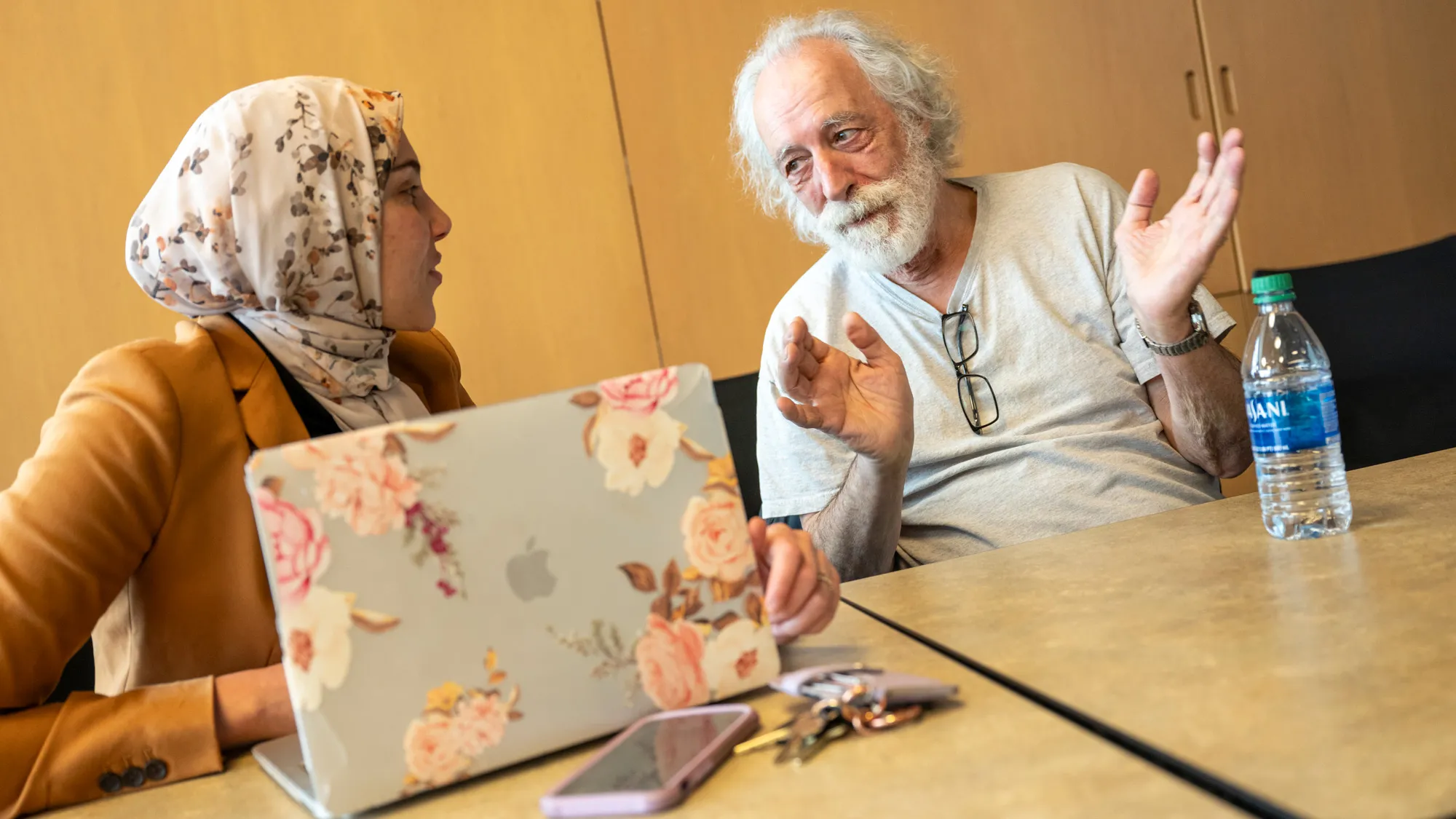
Grad student Dina Eissa and Agostini talk at a lunchtime confab of the Agostini-DiMauro Research Group and another in the Physics Department. “He’s known in our group for always asking good questions,” Eissa says. (Photo by Logan Wallace)
DiMauro says he acquired his attitude toward research while working for Bell Labs in the 1980s, in its golden age of monopoly — no pressure to drive profits, but certainly pressure to innovate. “They tell you, ‘We hired you because we’ve been told you’re gonna build a new field.’ They set very high bars in terms of you being a successful scientist.
“We all contributed. Scientists define a field, build a field. That’s why people like Pierre get a Nobel Prize. I always believed the work was good enough. I would see the wake of that through publications and how people cite them. People are paying attention. I don’t want to be doing anything where I’m the only one who cares about it.”
Clearly, people and the world of physics care about what is happening at Ohio State, where the Department of Physics is leading in many ways. It is one of the largest departments at the university, with 55 faculty members, 200 graduate students and 500 undergraduates, 80% of whom are engaged in research. Invited speakers visit campus throughout the year — L’Huillier will deliver the annual Alpheus Smith lecture in August. Kicking off now is the NSF-funded NeXUS Facility, a laboratory with laser capability that’s so fast, it’s a first in the United States.
The potential for discoveries made here, by students and professionals, seems endless.
One student at the April colloquium on campus asked Agostini to share his best piece of advice for aspiring scientists. “My motto now is don’t worry about applications,” he said. “Applications will come in time if you have the experiments and if you have the right ideas. But just don’t worry about that when you do fundamental research.”
That sentiment is echoed by Peter Mohler, the executive vice president overseeing Ohio State’s Enterprise for Research, Innovation and Knowledge and chief scientific officer of Wexner Medical Center.

“There is inherent value in having foundational knowledge in our fields. It forms the basis of curiosity and ideas that others will take to create the next level of foundational knowledge,” Mohler says. “It often takes years for foundational knowledge to turn into translational knowledge.”
Meanwhile, students are mentored and trained through the creation of all that knowledge and make their own marks after graduation. “The academic mission is felt across the university in many different ways,” Mohler says. “That’s the fun part of what we do here. We see the impact today.”
Now that scientists can track events at the attosecond level, research moves that much closer to controlling these events. Control is where the science can expand beyond the laboratory.
“In the attosecond regime, we think that what we’re doing is freezing the motion of the electron,” DiMauro says. “We’ve reasoned that, if we can take a sequence of photographs of the electron and see how it’s changing, then that means at some point in time, as it’s evolving, we can intervene and change its destiny. That’s the concept of control.”
Master control and you can apply this science, in theory, to energy, technology, national security, who knows what other fields. For instance, Krausz, one of Agostini’s fellow Nobel laureates, has demonstrated how attophysics could enable medical diagnoses at the atomic level.
We may, in fact, be standing at the precipice of profound new understandings of matter and our universe. As Agostini said in a talk he gave at Ohio State in April, “We don’t do physics for attoseconds.” The attosecond, marvel though it may be, is a tool that allows physicists and other scientists to get that much closer to understanding subatomic particles and how they might be of use to humanity.
Powering research and innovation
An endowment that Edward E. and Sylvia Hagenlocker created 24 years ago for the Department of Physics helps power Professor Lou DiMauro’s research and the Agostini-DiMauro Research Group. Edward Hagenlocker earned three physics degrees from Ohio State, a bachelor’s and master’s in 1962 and a PhD in 1964. He had a distinguished career as a research scientist and executive at Ford Motor Co. and is a lifetime member of The Ohio State University Foundation Board of Directors. Endowments support the university’s core mission of education, research, knowledge creation and community service.
